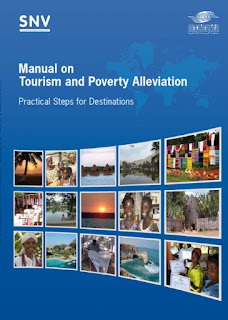OMT: MANUAL DE TURISMO Y ALIVIO DE LA POBREZA PASOS PRÁCTICOS PARA LOS DESTINOS (VERSIÓN EN INGLES)
Manual on Tourism and Poverty Alleviation Practical Steps for Destinations
MANUAL DE TURISMO Y ALIVIO DE LA POBREZA
PASOS PRÁCTICOS PARA LOS DESTINOS
El manual se divide en tres partes principales, basadas en los tres componentes clásicos de un ciclo de proyecto: Análisis / Planificación, Acción y Evaluación.
La PARTE 1 abarca el análisis y la planificación. Muestra cómo tomar en cuenta el alivio de la pobreza al considerar a las partes interesadas y los beneficiarios, analizando el desempeño actual del turismo, considerando el potencial futuro y desarrollando una estrategia y un plan de acción.
La PARTE 2 cubre la acción. Proporciona detalles sobre las formas prácticas de proporcionar beneficios turísticos a los pobres, sobre la base de siete mecanismos identificados previamente por la OMT. Estos incluyen: empleo directo; cadenas de suministro; Venta informal; desarrollo empresarial; Impuestos y cargas; Donación voluntaria; Y beneficios colaterales.
La PARTE 3 cubre la evaluación. Se examina el uso de indicadores y procesos de medición para evaluar el impacto del turismo y las iniciativas individuales sobre la pobreza.
El manual se puede utilizar:
• Como publicación consultiva independiente y fuente de referencia.
• Para estimular el pensamiento y la respuesta. Al final de cada sección hay cajas que invitan al lector a pensar en cómo el contenido se aplica a su propio destino.
• Apoyar programas breves de capacitación. En el Anexo 5 figura una sugerencia para un posible programa.The manual is in three main parts, based on the three classic components of a project cycle: Analysis/ P
lanning, Action and Assessment.
PART 1 covers analysis and planning. It shows how to take poverty alleviation into account in considering stakeholders and beneficiaries, analysing the current performance of tourism, considering future potential and developing a strategy and action plan.
PART 2 covers action. It provides details on practical ways of delivering tourism benefits to the poor, based on seven mechanisms previously identified by UNWTO. These include: direct employment; supply chains; informal selling; enterprise development; taxes and charges; voluntary giving; and collateral benefits.
PART 3 covers assessment. It looks at the use of indicators and measurement processes to evaluate the impact of tourism and individual initiatives on poverty.
The manual can be used:
• As a stand alone advisory publicationand reference source.
• To prompt thought and response. At the end of each section are boxes which invite the reader to think about how the content applies to his/her own destination.
• To support short training programmes. A suggestion for a possible programme is provided in Annex 5.
__________________________________
Fuente original: http://kaipachanews.blogspot.com/2017/05/omt-manual-de-turismo-y-alivio-de-la.html
Ultimas entradas





